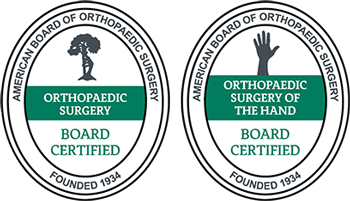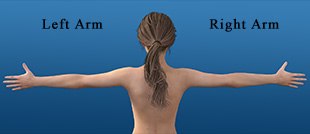Can You Dislocate Your Wrist?
Your wrist is an essential joint that helps you perform various daily activities, from spooning your morning cereal to driving your car to work. Sudden impact can dislocate any of the small bones in your wrist. This is a painful injury that requires prompt medical treatment. Knowing how to tell if your wrist is dislocated will help you take the proper steps before your injury worsens. If you think your wrist is dislocated, book an appointment with The Hand and Wrist Institute today.
Contents
Understanding Wrist Dislocation

person holding hands of another person by Towfiqu barbhuiya is licensed with Unsplash License
A dislocated wrist, also known as a carpal dislocation, occurs when the bones in the wrist joint are forced out of their proper position. This happens when your wrist sustains the force of a sudden impact, which can tear the ligaments holding your wrist bones in place, destabilizing the joint and causing dislocation. A wrist dislocation can affect any of the eight carpal bones in your wrist, occurring at the radiocarpal joint, distal radioulnar joint, midcarpal joint, or any combination of these.
The capitate and lunate are the most commonly dislocated bones in the wrist. The capitate is located in the center of the lower palm, and the lunate sits between the capitate and the long forearm bone called the ulna. An anterior lunate dislocation occurs when the lunate bone twists while surrounding bones remain in place. This type of dislocation accounts for about 10% of all wrist injuries. A perilunate dislocation occurs when the lunate bone and its three surrounding ligaments are all impacted by the dislocation.
A wrist dislocation may be accompanied by a wrist fracture, which is a partial or complete break of any of the wrist bones.
Symptoms and Diagnosis
Common dislocated wrist symptoms include the following:
- Sudden pain at the time of the injury
- Tenderness after the injury
- Bruising or discoloration
- Numbness or tingling in the fingers
- Deformity
- Swelling
- Redness
- Weakness or inability to manipulate the wrist properly
Your doctor will diagnose the dislocation with a physical examination and tests to confirm the initial findings. These commonly include a diagnostic X-ray or MRI to assess the bones and tissues in your wrist.
Causes and Risk Factors
Wrist dislocation is most commonly caused by a high-impact injury. This can occur if you slip and fall forcefully on your outstretched hand. A car accident that causes trauma to your hand or forearm can also dislocate your wrist. If you engage in high-impact sports, such as hockey or football, you may dislocate your wrist in the course of the game if your outstretched hand makes contact with another player or piece of sports equipment.
Ongoing pressure can also cause your wrist bones to slip out of place. If you walk on crutches for a long time and put repeated strain on your wrist, it can weaken the ligaments and ultimately lead to a dislocation. Pay close attention to anything that causes lingering pain or discomfort in your wrist and adjust your activities, if possible, to give your strained wrist time to heal before it becomes dislocated.
Treatment Options
Each case is different when dealing with a dislocated wrist. You should seek medical attention immediately following your injury. It’s often best to consult with a wrist specialist. Some dislocations are easy to miss or misdiagnose. A highly trained specialist with extensive experience in treating this part of the body is more likely to spot the subtle indications of less common dislocations.
Initial First Aid for Suspected Wrist Dislocation
Immediately after you injure your wrist, you should follow the rest, ice, compression, and elevation method, which involves the following:
- Resting the joint
- Icing your wrist
- Applying compression
- Elevating the injured area
Anti-inflammatory medication may provide some pain relief. Schedule an appointment with a healthcare provider as soon as possible after a wrist injury. Failure to properly diagnose and treat a wrist fracture can lead to complications. A dislocated bone can put pressure on the carpal tunnel, which contains nerves and blood vessels. If the blood supply to the wrist bone is severely disrupted, the bone tissue can die, leading to deterioration of the joint and eventual arthritis.
Professional Medical Treatments
A reduction is the most common dislocated wrist treatment. This outpatient procedure can be performed with either local or general anesthesia. During the procedure, your doctor will maneuver the displaced bones back into place, after which you should wear a cast or splint to keep your wrist immobilized while it heals.
In severe cases, you may need surgery for wrist dislocation. The surgical procedure involves exposing parts of the joint so your doctor can realign the wrist bones and repair the ligaments. Depending on the nature of the injury, your surgeon may also use pins or screws to secure the wrist bone and help prevent future injury.
Recovery and Rehabilitation: What To Expect
Recovery time for a reduction is typically two or three months. It takes longer to recover from wrist surgery. You may need six to 12 months to fully recover from a surgical repair. At some point during your recovery, your doctor will instruct you to begin physical therapy. It’s crucial that you follow through with all prescribed physical therapy exercises to regain flexibility and strength in your wrist.
Prevention and Long-Term Outlook
If you’ve sustained a wrist dislocation, it’s wise to wear a wrist brace when engaging in strenuous activity that puts pressure on the wrist. Even after recovery, your wrist may still be weaker and more susceptible to injury than it was before. Using a wrist brace for high-impact sports or activities that may cause persistent strain on your wrist may also help prevent dislocation in the first place.
Contact The Hand and Wrist Institute Today
If you suspect a wrist dislocation, schedule an appointment for an expert assessment and treatment plan at The Hand and Wrist Institute. Dr. Knight is a skilled orthopedic surgeon who specializes in minimally invasive wrist treatments. Contact us to make your appointment today.

























